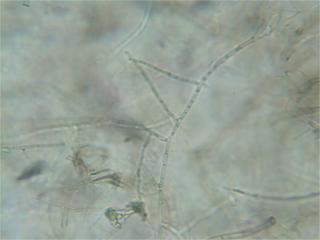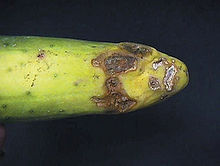- Rhizoctonia solani
-
Rhizoctonia solani (Anamorph) 
R. solani hyphae showing the distinguishing right angles Scientific classification Kingdom: Fungi Phylum: Basidiomycota Class: Agaricomycetes Order: Cantharellales Family: Ceratobasidiaceae Genus: Rhizoctonia Species: R. solani Binomial name Rhizoctonia solani
J.G. Kühn 1858Synonyms Moniliopsis aderholdii Ruhland 1908
Moniliopsis solani (J.G. Kühn) R.T. Moore 1987
Rhizoctonia grisea (J.A. Stev.) Matz 1920
Rhizoctonia napaeae Westend. & Wallays 1846Rhizoctonia solani (teleomorph: Thanatephorus spp.) is a plant pathogenic fungus with a wide host range and worldwide distribution. This plant pathogen was discovered more than 100 years ago. Rhizoctonia solani frequently exists as thread-like growth on plants or in culture. Asexual spores are not produced, only the sexual stage is known. The Sexual spores are observed on diseased plants, these spores are categorized to make plant pathogen a basidiomycete. Rhizoctonia solani attacks many hosts and produces a variety of symptoms. Rhizoctonia Solani is known to cause serious plant losses by attacking primarily the roots and lower stems of plants and although they have a wide range of host their main targets are herbaceous plants. Disease cycle is important to understand for disease management in certain stages of life.
Contents
Importance and History
In 1858, Julius Kuhn observed a fungus on diseased potato tubers and named in Rhizoctonia solani. This is a widespread, destructive, and versatile plant pathogen. The fungi occurs in all parts of the world, and is capable of attacking many different host plants, causing seed decay, damping-off, stem cankers, fruit decay, and foliage diseases.
Biology
Rhizoctonia solani produces hyphae in large masses called mycelium. Due to the production of mycelium these soil inhabiting pathogens are referred to as "sterile fungi". The mycelial cells of this species contain many nuclei whereas other rhizoctonia pathogens only have 2 nuclei per mycelium. The hyphae have characteristics of: shades of brown, cross walls, multinucleate cells, branches produced at right angles, and no asexual spores. When grown in culture, the growth rate of Rhizoctonia solani is very fast. Small, oval cells are produced in branched chains. They have thick walls and sclerotia 3 to 5 mm long can be seen. This species is thought of as a "collective" species since it consists of several more or less unrelated strains. An important characteristic of rhizoctonia solani is their abilitiy to perform anastomosis(hyphal fusion) which only occur between isolates of the same group. There are 4 main anastomosis isolated groups that are known to this day, and these are important to classify for innoculating/in breeding crops for resistance to the pathogen. Each group is described/classified by the symptoms it causes on its hosts. Example- AG1-all isoltates cause seed and hypocotyl rot/ aerial blights. AG2-canker of root crops, wire stem on crucifers and brown patches on turf.
Sexual spores are formed on basidia. Four spores are produced on each basidium. Each basidiospore has one nucleus, and are formed when the environment is moist. When spores go through anastamosis and fuse, new hyphae with a mixture of different nuclei are formed.
Rhizoctonia solani are saprophytic, soil inhabitants, and feed on dead organic matter.
Hosts and Symptoms
Rhizoctonia solani primarily attacks below ground seeds and roots of plants, but can also infect pods, roots, leaves and stems. The most common symptom of Rhizoctonia is "damping off", or non germination of infected seeds. Damping off is the decay of the stem at about soil level, causing the plant to fall over because it does not have thick enough supporting tissue. Root rot is also an important symptom of Rhizoctonia solani. Seeds that do germinate before being killed by the fungus have reddish-brown lesions and cankers on stems and roots.
Rhizoctonia may invade the seed and cause seed decay wile the seed is still in the fruit. This may cause decaying the seed in the fruit or just infecting Damping off of seedlings can occur in the preemergence phase. Bad environmental conditions gives the seedling a higher risk of being infected by Rhizoctonia solani. Postemergence damping off is a further delay in attack of Rhizoctonia solani. The seedling is most susceptible to disease in its juvenile stage.
Cereals in areas of England, South Australia, Canada, and India endure loses caused by Rhizoctonia solani. Roots are killed back and brown stumps, causing plants to be stunted and spindly. In England, this is called purple patch. Rhizoctonia solani also can cause hypocotyl and stem cankers on mature plants of tomatoes and cabbage. Strands of mycelium and sometimes sclerotia appaear on their surfaces. Roots will turn brown and die after a period of time. The best known symptom of Rhizoctonia solani is the black sclerotia on potato tubers.
Host range of the fungus is very wide. Strains of Rhizoctonia solani may differ in: the hosts they are able to attack, the virulence of attack, ranging for a given host from nonpathogenic to highly virulent, the temperature at which the attack will occur, the ability to develop in lower soil levels, the ability to form sclerotia, the growth rate, the survival in a certain area. These factors may or may not show up given the environment and host that Rhizoctonia attacks.
Disease Cycle
Rhizoctonia solani can survive many years in sclerotia in soil and plant tissue. Sclerotia with thick outer layers allow for survival and these sclerotia act as the overwintering spore for the pathogen. This plant pathogen also survives as mycelium in organic matter. The fungus is attracted to the plant by chemical stimuli released by a growing plant and/or decomposing plant reisude. The process of penetration of a host can be accomplished in a number of ways. Entry can occur through the cuticle and epidermis, or through natural openings of the plant. Hyphae will come in contact with the plant and attach to the plant. The fungus continues to grow and produces an appresorium that penetrates the plant cell and allows for the pathogen to get nutrients from the plant, also using hyphae to go into the plant cells. The pathogen also releases enzymes that breaks down plant cell walls, and continues to colonize and grow inside dead tissue. This forms sclerotia. New inoculum is produced on or in the host tissue, and a new cycle is repeated when new plants become available.
Envrionment
Identification
 R. solani infection on cucumber
R. solani infection on cucumber
Thanatephorus spp. (Teleomorph) Scientific classification Domain: Eukarya Kingdom: Fungi Phylum: Basidiomycota Class: Agaricomycetes Order: Cantharellales Family: Ceratobasidiaceae Genus: Thanatephorus Species: Thanatephorus spp. Binomial name Thanatephorus spp.
(A.B. Frank) Donk 1956Synonyms Corticium sasakii (Shirai) H. Matsumoto 1934
Corticium solani (Prill. & Delacr.) Bourdot & Galzin 1911
Corticium vagum var. solaniBurt 1903
Hypochnus cucumeris A.B. Frank 1883
Hypochnus filamentosus Pat. 1926
Hypochnus sasakii Shirai 1906
Hypochnus solani Prill. & Delacr. 1891
Pellicularia filamentosa (Pat.) D.P. Rogers 1943
Pellicularia filamentosa f. sp. sasakii Exner 1953
Pellicularia sasakii (Shirai) S. Ito 1955
Thanatephorus sasakii Shirai) C.C. Tu & Kimbr. 1978Rhizoctonia solani does not produce spores and is hence identified only from mycelial characteristics or DNA analysis. Its hyphal cells are multinucleate. It produces white to deep brown mycelium when grown on artificial medium. The hyphae are 4–15 μm wide and tend to branch at right angles. A septum near each hyphal branch and a slight constriction at the branch are diagnostic. R. solani is subdivided into anastomosis groups (AG) based on hyphal fusion between compatible strains.[1][2]
The teleomorph of R. solani is Thanatephorus cucumeris. It forms club-shaped basidia with four apical sterigmata on which oval, hyaline basidiospores are borne.
Management
It is not possible to completely control Rhizoctonia diseases, but it can be limited. Successful control of Rhizoctonia depends on characteristics of the pathogen, host crops, and environment. The strains are extremely variable in specialized responses to specific host plants and in symptom production, temperature relations, physiological response, and resistance of fungicides. Effective management of this plant pathogen can involve cultural and chemical controls, as well as avoiding transmission with propagating material, time of seedling, seed bed preparation, crop sequence, bioloigcal control, resistance. One specific chemical option is referred to as PCNB which can help reduce damping off of seeds. To minimize disease, we can use plant certified seed that is free of sclerotia. Seed growers should plant only sclerotia-free seed. Planting seed in warm soil (above 46 degrees F) and veering them with as little soil as possible reduces risk of stem canker. Avoidance is one of the key ways to ensure that one will not have the pathogen amongst their crops as long as they stay clear of wet, poorly drained areas. Diseases caused by this pathogen are more severe in soils that are moderately wet and a temperature range of 15-18 degrees C. Increasing the rate of crop residue decomposition reduces the growth rate of Rhizoctonia because of the release of carbon dioxide. Carbon dioxide reduces the ability of the pathogen. Vine removal and burning also reduces the amount of overwintering fungus for the next season.
References
- ^ Wiese, M.V. (1987). Compendium of wheat diseases. American Phytopathological Society. pp. 124 pp..
- ^ APSnet Education Center - Plant Disease Lessons - Rhizoctonia disease of turfgrass - Pathogen Biology. Plant Pathology / Plant Disease Online - The American Phytopathological Society.
Rhizoctonia solani.[1]
Categories:- Cantharellales
- Plant pathogens and diseases
- Plant disease stubs
Wikimedia Foundation. 2010.
